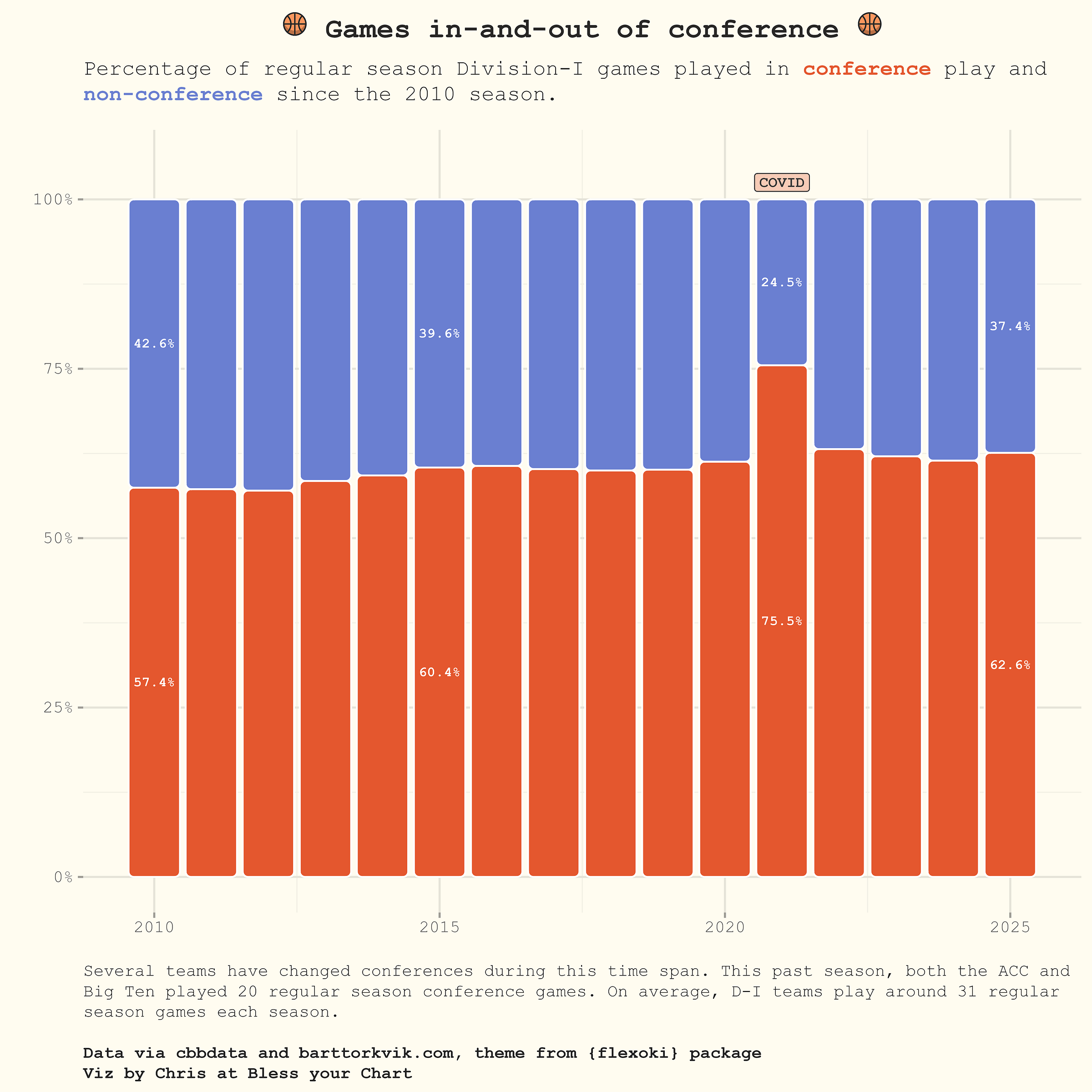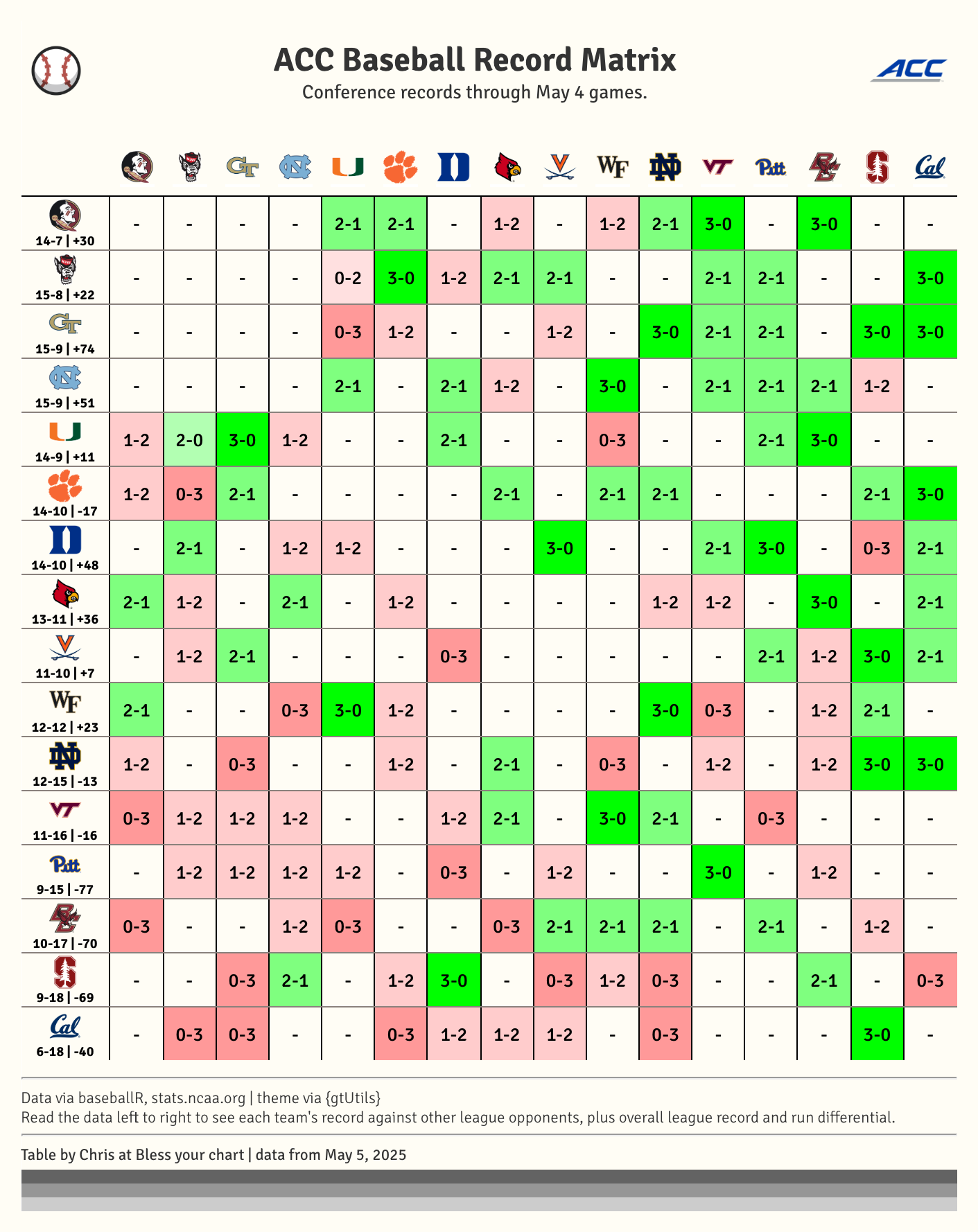142: The ACC's schedule adjustments
A look at how college basketball scheduling has changed over time, plus ACC baseball matrix of results.
Last week, CBS Sports' Brandon Marcello reported that ACC basketball plans to cut its conference schedule from 20 to 18 games next season. On the surface, it’s a small change, but a change that signals the league is finally trying to help itself.
As David Teel noted at the end of the regular season, ACC teams played 180 conference games. Not one of those games featured two teams ranked in the AP Top 25. Only four of the league’s 18 members made the NCAA Tournament. That’s not a recipe for national respect.
ACC teams were a combined 17-52 against the other power conferences. And as many have been quick to react to the scheduling news, the fewer games in conference means nothing if the teams can’t win games outside of the conference. No shit, Dick Tracy.
But dismissing this adjustment outright misses the bigger picture. Earlier this year, I wrote about how the this wasn’t your father’s ACC and the league could use a creative overhaul when it comes to its schedule. A reduction in the number conference games is a step in that direction, especially when you consider the broader trend in scheduling across all of college basketball.
Back in the 2009-10 season, about 43 percent of Division-I games were played out of conference. Fast forward to this past season, and that number has dropped below 38 percent.
As leagues like the ACC and Big Ten ballooned in size, more and more games were pulled in-house. This past season, both leagues had their teams play 20 conference games. Less room for meaningful non-conference matchups. Less room to prove yourself nationally.
Here is how the distribution of conference and non-conference games has changed since the 2009-10 season.
The 2020-21 season is an outlier due to COVID when a whopping 75.5 percent of regular season games were played within the same conference. Keep in mind several teams also played fewer than 30 regular season games1 that season too.
The annexation of the Pac-12 into the Big Ten, ACC, and Big 12 over the past couple seasons has created even larger leagues than before. The conferences are bloated, fewer non-conference games are played, and those non-conference games are important when it comes to Selection Sunday in March.
Two things that often get overlooked about the NCAA’s NET rankings:
There are no preseason priors. The NET doesn’t know or care where a team was ranked in October. The early-season results in November lay the foundation for the entire season.
Location matters a lot. A road win against a decent team is far more valuable than a blowout win over the same decent team at home. Neutral site wins against average or bad teams can carry more weight than a convincing home win against those same type of teams.
This brings us to when these conference and non-conference games are played.
Historically, the majority of non-conference games have been played before the new year begins or prior to January 1st. The number of non-conference games played after January 1 have become an endangered species.
Here’s how dramatically things have shifted:
During the 2009-10 season, 536 non-conference games were played after January 1 (5.4 percent of all games)
This past season (2024-25) just 28 non-conference games were played after January 1 (0.3 percent of all games)
I don’t expect the reduction of two ACC games to deliver the league more at-large bids to the NCAA Tournament or dramatically change the perception of the league right away. You need better players, better coaches, and probably some luck to turn the tide on the reputation of the league in one season.
Given the lack of preseason priors in NET rankings combined with fluid rosters2 due to the transfer portal, it would behoove conference commissioners to consider playing more non-conference games later in the season.
Over time, I hope the ACC tries to get creative. The league should consider when and where its games are played to allow its members to put together a better schedule.
Marcello’s report suggests the ACC’s new schedule could feature each team playing 16 opponents once, plus a second game against a permanent rival. That’s fine, but no need to be this rigid. If Cal and Boston College don’t play one year in basketball, life will go on. It happens in other sports already and the schedule should be dynamic based on every team’s performance.
More importantly, if traditional rivals like North Carolina and NC State only get to play once each season, get creative and stage a neutral site matchup. Bring back the Big Four Tournament. Make it an event.
Even the ACC Tournament itself could be reimagined. Why not play a few league games at neutral sites earlier in the season? A preseason or play-in tournament for the league’s main event or cocktail party later in March.
The ACC could follow same format as the Sun Belt and MAC used this past season, and do two separate challenges with another league and dynamic set of opponents. Imagine a second SEC-ACC challenge in February, would ESPN not welcome that?
In other college sports, there’s already more flexibility and imagination.
ACC football teams play eight of 12 games in-conference. Yet late-season non-league games—like Clemson vs. South Carolina—often can shape the national conversation around the playoff.
ACC baseball teams play around 45 percent of their schedule out-of-conference, with a clear structure: midweek non-league games, weekend three-game series against league opponents.
Basketball could learn something from that. Yes, the leagues are bloated, and no, there’s no perfect fix (outside of contraction). But a little creativity and flexibility could go a long way toward rebuilding the ACC's standing nationally.
ACC baseball update
On the topic of baseball, there are only two weekends left in the regular season before the ACC baseball tournament starts in Durham, NC on May 20.
All 16 teams are invited to the tournament, and the teams will play in a single elimination format. League schedules are quite unbalanced, so let’s take a look at a matrix of results for all the teams in the league:
One key series is on the docket this weekend when NC State heads to Chapel Hill to face UNC, starting Thursday, May 8 at 6 pm. With some of the top teams still having yet to play each other, this series could have a big impact on the bracket later this month.
🤟 That’s it for this week, and thanks for reading this far 🤟
This week’s recommendations
Check out this episode of the Young Man and Three podcast with Steve Nash and Cam Johnson. I’m biased, but Cam Johnson is really good at breaking down the technical aspects of basketball. It’s refreshing to see a former UNC player3 in the media talk about the game this way.
I also finished Jeff Pearlman’s book, The Last Folk Hero: The Life and Myth of Bo Jackson, and recommend it yet again. Jackson is a fascinating human being and athlete. It’s mentioned in the book, but I had to look up the Tecmo Super Bowl video on YouTube. Jackson is the best video game athlete of all time.
DePaul played fewer than 20 games during the 2020-21 season. They finished with a 5-14 overall record and were coached by former Virginia head coach Dave Leitao.
Somewhat related, I find it hilarious how we’re already stating certain college football schedules are easy. We don’t even know who the hell is on half the teams yet.
Not sure I can remember a more unsettling week of news around Carolina football and basketball than this past week. Less soap opera and more success, please and thank you.






